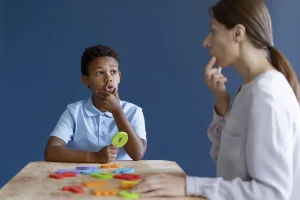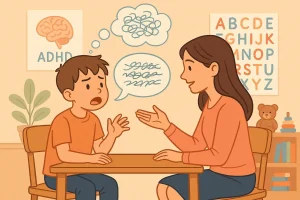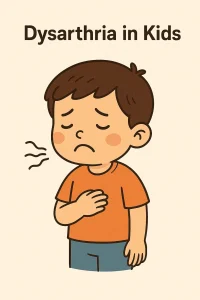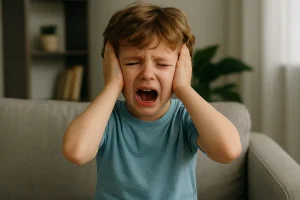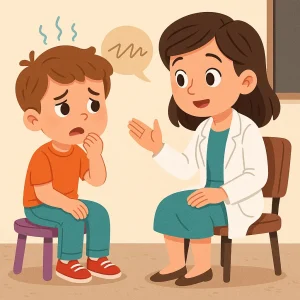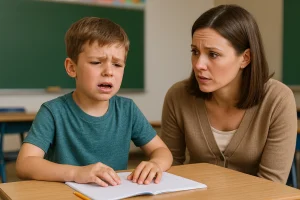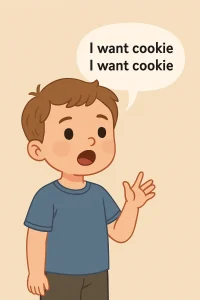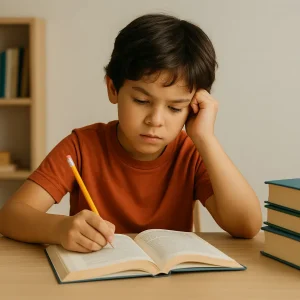WH Questions Worksheets for Kids Ages 3-6: A Simple Guide
By Rajini D
Last Updated: February 17, 2025
Understanding WH questions—Who, What, When, Where, Why, and How—is essential for early childhood development, enhancing both language skills and critical thinking. To support this crucial learning phase, Wellness Hub offers “Printable WH Questions Worksheets for Kids” tailored for ages 3 to 6. These engaging worksheets are designed to make early education both fun and effective, helping young learners master the basics of communication and comprehension effortlessly. Join us in exploring these valuable resources that promise to make learning an exciting adventure for your child.
Why Are WH Questions Important for Kids Ages 3-6?
Children are naturally curious, always asking questions about the world around them. WH questions—Who, What, When, Where, Why, and How—are essential for helping kids develop strong communication skills and better understand their surroundings. These questions guide conversations, improve comprehension, and encourage kids to think critically.
Understanding WH Questions
Each WH question serves a different purpose in learning and communication:
| WH Question | Purpose | Example |
|---|---|---|
| Who | Identifies a person | Who is your teacher? |
| What | Asks about things or actions | What is your favorite toy? |
| When | Refers to time | When do you go to bed? |
| Where | Refers to places | Where is your school? |
| Why | Asks for reasons | Why is the sky blue? |
| How | Explains a process or manner | How do you tie your shoes? |
Also read: WH Questions for 3-Year-Olds | Boost Speech & Thinking Skills
Why Are WH Questions Important for Kids?
Teaching WH questions is crucial for language and cognitive development, especially between the ages of 3 to 6, when children are rapidly learning to communicate. Here’s why:
- Boosts Language Skills – Encourages children to form complete sentences and express their thoughts clearly.
- Enhances Critical Thinking – Helps kids analyze situations and develop problem-solving skills.
- Improves Social Interaction – Enables children to engage in conversations, ask for help, and share ideas.
- Builds Early Literacy Skills – Strengthens reading comprehension by helping kids understand story elements like characters (Who), settings (Where), and events (When).
Benefits of Using Printable WH Questions Worksheets
Using educational resources effectively can significantly impact early childhood learning. This is where free printable WH questions worksheets come into play, especially those crafted by Wellness Hub. These worksheets are not just a learning tool; they are designed with the developmental needs of young children in mind, making them a valuable asset for both parents and educators.
Educational Benefits of WH Questions Worksheets
WH questions worksheets offer several educational advantages:
- Structured Learning: These worksheets provide a structured approach to learning, helping children grasp the concepts of who, what, when, where, why, and how in a clear and organized manner.
- Enhanced Engagement: By incorporating colorful and interactive elements, these worksheets keep children engaged. This is crucial in maintaining their attention and fostering a love for learning.
- Skill Development: Regular practice with these worksheets enhances critical thinking, reading comprehension, and communication skills. They encourage children to form complete sentences and articulate their thoughts.
Tailored to Meet Developmental Needs
Wellness Hub’s worksheets are specifically designed to align with the developmental stages of children ages 3-6. Here’s how they cater to young learners:
- Age-Appropriate Content: The worksheets use simple language and familiar scenarios that resonate with young minds, making it easier for them to relate and respond.
- Visual Aids: They include pictures and cues that help children understand the questions better, which is particularly helpful for visual learners.
- Incremental Learning: The complexity of the questions gradually increases, which helps in building confidence and competence in young learners over time.
Lear More: WH Questions for Kids with Autism: A Parent-Friendly Guide
How to Use Printable WH Questions Worksheets Effectively
Integrating WH questions worksheets into daily activities can transform routine learning into an exciting adventure for kids. Whether you’re a parent guiding your child’s home education or an educator shaping young minds in the classroom, Wellness Hub provides resources that are both fun and educational. Here are some tips and creative ideas to maximize the effectiveness of these printable worksheets.
Tips for Incorporating WH Questions Worksheets
- Daily Routine Integration: Incorporate WH questions into daily routines. For instance, while having a meal, you could ask, “What are you eating?” or “Why do you like apples?” Then, use the worksheets to reinforce these interactions with visual and written cues.
- Progress Tracking: Use the worksheets as a progress tracker. Start with simpler questions and gradually introduce more complex ones as the child’s understanding improves. This will help you measure how well they’re grasping the concepts.
- Interactive Sessions: Turn worksheet sessions into interactive learning moments. Read the questions aloud, discuss possible answers, and encourage your child to ask questions in return. This enhances their engagement and comprehension.
Creative Ideas to Make Learning Engaging
- Thematic Learning Days: Organize days around specific WH questions. For example, have a “Who Day” where every activity revolves around identifying people in stories, pictures, and real life.
- Incorporate Games: Turn the worksheets into games. For instance, create a treasure hunt where each clue answers a WH question leading to the next clue. This makes learning dynamic and enjoyable.
- Use of Technology: Utilize tablets or computers to access Wellness Hub’s digital resources. Interactive elements like clicking, dragging, and watching related educational videos can make the learning experience more vibrant.
- Story Integration: Use children’s favorite stories to frame questions. After reading a book, use the worksheets to ask questions like, “What did the main character do at the end?” or “Why did the story end that way?” This not only improves comprehension but also makes the connection between the worksheets and enjoyable activities.
- Creative Arts: Combine arts and crafts with WH questions. After completing a worksheet, have the child draw a scene that answers a “Where” question or craft an object that relates to a “What” question. This approach helps in retaining their interest and enhancing their creative skills.
Read More: How WH Questions Help Kids Improve Their Communication Skills
Step-by-Step Guide to Introducing WH Questions to Preschoolers
Teaching WH questions to preschoolers requires a gentle and progressive approach. By introducing these fundamental question types one at a time, you can help young learners build confidence and comprehension skills at a comfortable pace. Below is a detailed, step-by-step guide to help you integrate WH questions into your teaching routine using Wellness Hub’s worksheets, along with examples of simple activities that can be done alongside these resources.
| Step | WH Question Type | How to Introduce | Activity Example |
|---|---|---|---|
| 1 | Who | Start with familiar people. Ask questions about family members or characters in their favorite books. | Activity: Show pictures of family members and ask, “Who is this?” |
| 2 | What | Introduce objects and actions. Focus on things around the house or in the classroom. | Activity: During snack time, ask, “What are you eating?” or “What is this?” while pointing to objects. |
| 3 | Where | Discuss locations within familiar environments, like home or school. | Activity: Hide a toy and ask, “Where is the teddy bear?” Encourage them to find it and describe the location. |
| 4 | When | Talk about parts of the day or simple routines. | Activity: Ask questions like, “When do we sleep?” or “When do we eat lunch?” Use a daily routine chart to help them answer. |
| 5 | Why | This is more challenging. Start with simple cause and effect that they can observe directly. | Activity: If it’s raining, ask, “Why do we use an umbrella?” after showing them it’s raining outside. |
| 6 | How | Focus on processes or methods they see in daily life. | Activity: When coloring, ask, “How do you use your crayons?” Encourage them to explain the process of choosing colors and using them on paper. |
Top WH Questions Worksheets for Kids Ages 3-6
At Wellness hub, we understand the importance of foundational language skills for young learners. That’s why we’ve developed a range of engaging WH questions worksheets specifically designed for kids ages 3 to 6. Each worksheet is tailored to help children master different aspects of WH questions, focusing on understanding and applying each type in context. Here, we highlight some of the most popular worksheets and their specific focus areas to help you choose the right tools for your educational needs.
Popular WH Questions Worksheets
| Worksheet Title | WH Question Focus | Description |
|---|---|---|
| Who in My World? | Who | This worksheet helps children identify people around them, from family members to community helpers. It uses pictures and simple sentences to ask “Who is this?” enhancing recognition and social understanding. |
| What’s That Object? | What | Focused on objects and their uses, this worksheet encourages children to link objects with their purposes, asking questions like “What do we use to eat?” It’s great for building vocabulary and understanding of everyday items. |
| Where Do I Find It? | Where | Designed to improve spatial awareness, this worksheet asks children to identify locations of common objects, such as “Where do we keep the toys?” It helps establish a sense of order and place. |
| When Do Things Happen? | When | This worksheet introduces concepts of time through daily routines, asking questions like “When do you brush your teeth?” It aids in developing a routine and time-telling skills. |
| Why Do We Do That? | Why | Exploring reasoning, this worksheet challenges children to think about cause and effect, with prompts like “Why do we wear a coat?” It’s perfect for initiating logical thinking and understanding consequences. |
| How Does It Work? | How | Focusing on processes, this sheet asks children to describe how things happen, such as “How do you make your bed?” It encourages descriptive thinking and sequence understanding. |
Conclusion
WH questions open up a world of learning for kids! At Wellness Hub, we offer printable WH questions worksheets that make learning fun and effective for children ages 3-6. These resources help enhance language skills and encourage curiosity.
Ready to boost your child’s development? Download our worksheets today and explore more exciting educational tools on our Resources Page. Each resource is designed to foster a love for learning that lasts a lifetime. Start your child’s journey of discovery with Wellness Hub—where learning meets fun!
Frequently Asked Questions:
1. What are WH questions for kids?
WH questions include Who, What, When, Where, Why, and How. They help children learn about people, objects, time, places, reasons, and methods through simple queries.
2. Why are WH questions important for preschoolers?
WH questions enhance language skills, critical thinking, and understanding of the world. They encourage preschoolers to communicate effectively and ask questions about their environment.
3. How can WH questions improve my child’s language development?
Practicing WH questions helps children build vocabulary, form complete sentences, and improve their overall communication skills.
4. What age should children start learning WH questions?
Children can start learning WH questions as early as age 3 when they begin to form more complex sentences and understand basic question concepts.
5. Where can I find printable worksheets for WH questions?
You can download high-quality, printable WH questions worksheets for kids ages 3-6 at wellness hub’s resources page.
6. How often should I practice WH questions with my preschooler?
Regular practice, such as a few times a week, is recommended to help your child gradually master these questions in different contexts.
7. Can WH questions worksheets be used for home schooling?
Absolutely! These worksheets are a fantastic resource for home schooling, providing a structured way to enhance language and cognitive skills at home.
8. What types of WH questions are easiest for kids to learn first?
“What” and “Who” questions are usually the easiest for young children to understand and answer, as they often involve visible objects or familiar people.
9. How do I make learning WH questions fun for my child?
Incorporate games, songs, and stories that include WH questions. For example, turn a worksheet session into a treasure hunt where each clue involves answering a WH question.
10. What should I do if my child struggles with answering WH questions?
Be patient and provide plenty of encouragement. Use visual aids and real-life examples to help explain the questions and possible answers more clearly.
About the Author:
Rajini Darugupally
M.Sc., Speech-Language Pathologist (9+ years of experience)
Rajini is a passionate and dedicated Speech-Language Pathologist with over 9+ years of experience, specializing in both developmental speech and language disorders in children and rehabilitation in adults. Driven by a desire to empower each individual to find their voice, Rajini brings a wealth of experience and a warm, genuine approach to therapy. Currently, at Wellness Hub, she thrives in a team environment that values innovation, compassion, and achieving results for their clients.
Book your Free Consultation Today
Parent/Caregiver Info:
Client’s Details:
* Error Message

